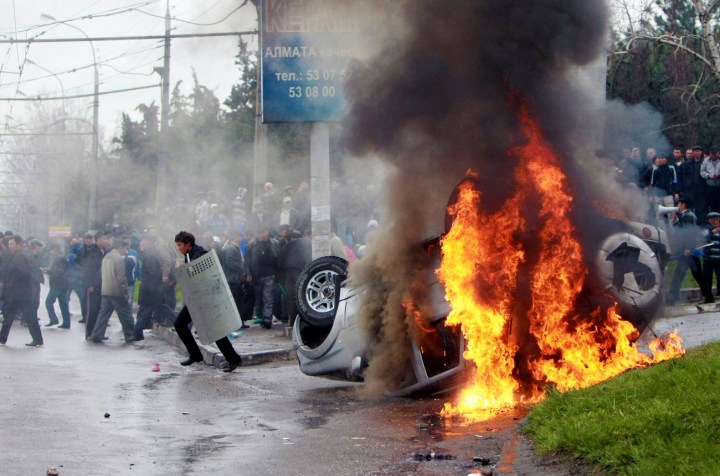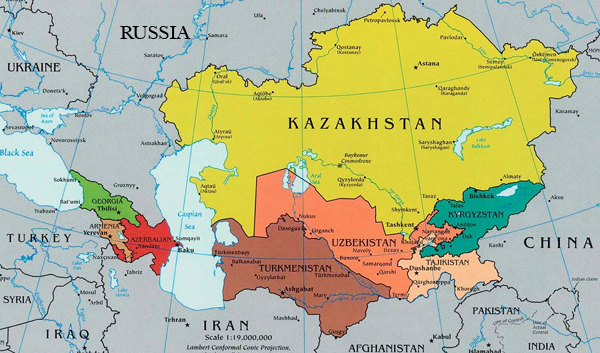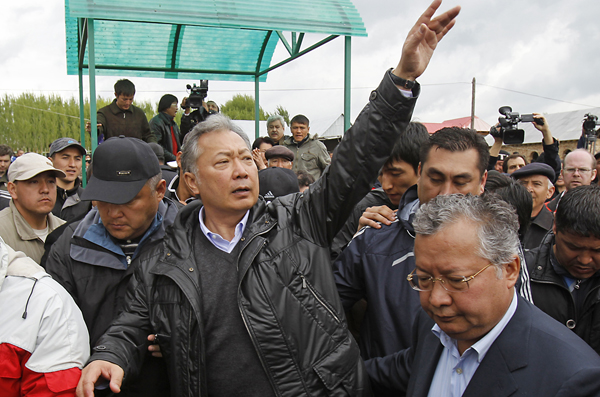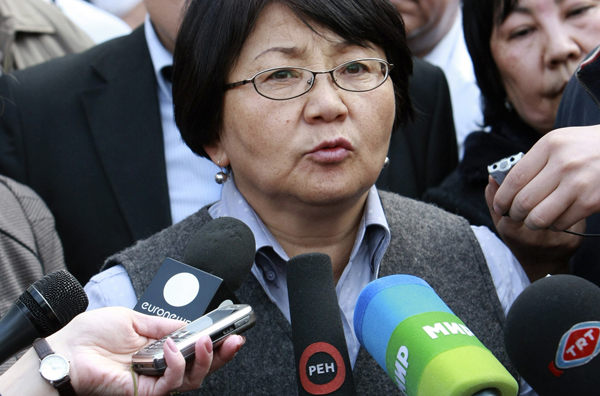Politics
Analysis: Trouble in Kyrgyzstan, just another Silk Road crash

To understand the events that are unfolding in Kyrgyzstan’s capital of Bishkek – the country’s president was prised out of office in the wake of police killing 81 protesters and the violent demonstrations that followed – we need to reach back through the region’s history. In some important ways, Kyrgyzstan’s current troubles may be the newest iteration of the quest for control or influence in Central Asia.
This quest stretches back through the British-Russian rivalry of the 19th century’s “Great Game”, and then deeper into history through the rise of the Mughal emperors in India; Timurlane’s brief, violent empire; the Mongol conquests and their khanates; the Arab invasion and, ultimately, a defeat by the forces of Tang China; the impact of Alexander the Great’s Hellenistic expansion; Herodotus’ near-legendary Scythians – and, of course, the trade routes of the age-old Silk Road.
Central Asia has been a cultural, religious and ethnic mixing bowl for as long as there have been records – and almost certainly long before that as well. With this much history, Central Asia’s textures became an inspiration to novelists and composers from the moment the Russians began to extend their reach into the region in the 19th century.
However, over the past twenty years, the vast stretches of Central Asia that were conquered by Russia in the late 1800s became five independent nations in the late 1991 break-up of the USSR in the wake of an attempted military coup against Mikhail Gorbachev. The region fractured into the separate nations of Kazakhstan, Turkmenistan, Uzbekistan, Kyrgyzstan and Tajikistan.

These new (or very old) nations, however, are inhabited by a patchwork of ethnicities that have Turkic and Tatar origins and the countries’ namesake nationalities – as well as ethnic spillovers from Afghanistan, Iran and, most sensitively for regional political stability – major ethnic Russian populations from when that country conquered the region. Depending on which geographer, anthropologist or historian you read, Central Asia also sometimes stretches as far as Xingjian, China’s westernmost, Muslim-dominated region, as well as the northern reaches of Afghanistan and even Pakistan, and some southern parts of Siberia and Mongolia.
The situation in Kyrgyzstan is currently causing the most tension for the region. The country’s nominal president, Kurmanbek Bakiyev, has just been forced from the capital to Teyit (500 kilometres to the south of Bishkek) after days of violent rioting and demonstrations. In an interview with the New York Times’ correspondent, Bakiyev insisted he still has popular support. As he stated: “They have changed all the leaders, but that does not mean that they have taken control. They have no authority, and no influence.” And, about the killing of demonstrators by presidential guard units, Bakiyev insisted: “The people who guard the White House [the Kyrgyz presidential residence] never shoot at peaceful citizens without a reason.” Boy, oh boy, does that sound familiar!
Bakiyev had fled Bishkek on Wednesday after demonstrators, upset over what they charged was a corrupt and repressive rule, clashed with police and the presidential guard, who in turn fired on the crowd, killing some 81 people and wounding many more. Despite this, the most recent reports say the capital is returning to a more general state of calm. A growing number of regional leaders have rallied to support the interim government led by Roza Otunbayeva (the former foreign minister) ensconced in the capital – or they are being replaced by Otunbayeva’s supporters. Meanwhile, Otunbayeva says Bakiyev should be arrested and tried for the deaths of those killed in the demonstrations last week – as well as other crimes.

Photo: Ousted President Kurmanbek Bakiyev greets a rally of a few thousand supporters in Teyyit, April 12, 2010. Kyrgyzstan’s interim government said on Monday it was planning a special operation against Bakiyev, who warned any attempt to seize him would result in bloodshed. REUTERS/Denis Sinyakov
And, while the new government has not yet been recognised by any other country, in part because of the sensitive circumstances around the US-leased base, secretary of state Hillary Rodham Clinton has already reached out to Otunbayeva, speaking with her on the phone on Saturday to begin the process of reaching a new accommodation with her.
Forcing Clinton’s hand into dealing with an unelected leader has been a vigorous American military presence there, connected to an eight-year-old war in Afghanistan. Despite the fact that interim president Roza Otunbayeva has said that the US air base lease would continue, some analysts fear that further developments in the country may yet threaten it.
The US’ use of Manas Air Base in Kyrgyzstan has become a vital link to the supply chain for America and Nato’s 100,000-plus military personnel in Afghanistan – as well as for supplies to the Afghan army. This has become crucial for the Americans – alternative approaches through Pakistan and then on into Afghanistan are both politically and militarily problematic, to say the least.
For the Americans, the $15 million a year they pay to lease the base is a great bargain – and it has become a vital opportunity for the Bishkek government to earn some difficult-to-come-by hard currency. This has created the extraordinary – unique – circumstance of a country that hosts both American and Russian military bases that have great strategic importance and reach – and in close proximity to each other.
In fact, charges that the ousted president’s family was profiting from the sale of jet fuel to US forces appears to have fuelled the protests that ousted the president last week. The entrenched cronyism of power in the Central Asian states means that political power often blends seamlessly with new wealth.

Photo: Roza Otunbayeva, the interim government leader, speaks to the media as she visits the victims of the uprising in a hospital in Bishkek, April 9, 2010. A crowd gathered in the burned out center of the Kyrgyz capital on Friday to mourn at least 75 people killed in an uprising that ousted the government and cast doubt over the future of a U.S. air base in the country. REUTERS/Vladimir Pirogov
Officials in the new, interim Kyrgyz government are already releasing details of what they say is an elaborate payment system (and kickbacks) for the approximately quarter million gallons of jet fuel used at the base each day. Ominously, interim president Otunbayeva’s chief of staff, Edil Baisalov, has told the press: “Whatever the Pentagon’s policy of buying warlords in Afghanistan, the state of Kyrgyzstan demands more respect. The government of Kyrgyzstan will not be bought and sold. We are above that.”
And so, this base now makes the political circumstances of a remote place like Kyrgyzstan (or any of the other four Central Asian republics for that matter) that previously had less than marginal interest for Americans, of great, growing concern to them. Strategically, there is yet another concern – Americans must contemplate and be aware of the possibilities of the destabilising infiltration of insurgents or their ideas from Afghanistan into Kyrgyzstan – either to distract the US further, or to carry out their own religious-political agendas. These new republics have, of course, been predominately Muslim for a long time and the region has had clashes between state and religion over the past twenty years as well. (Islam’s influence in the region actually stretches back almost 1300 years – the heretofore all-conquering Arab armies converted Central Asia before they were defeated by Tang China on the banks of the Talas River in 751AD.)
Not surprisingly, Russian Prime Minister Vladimir Putin has also reached out to Otunbayeva. Media reports indicate that the Russians had been working to undermine Bakiyev through a media onslaught and economic measures designed to inflame popular opinion against the deposed president. The net effect: Moscow has given a “heads-up, pay attention now” notice to the other autocrats in its Central Asian backyard who similarly govern substantial Russian-speaking minorities in their respective nations. In this way, it may have gained some new leverage over the future of that US air base in Kyrgyzstan.
Otunbayeva has reportedly told Clinton that the interim government envisions no immediate changes for the US air base – although its long-term status may now be unresolved. In previous years, the now-deposed president once tried to close the base, but he changed his mind when the US increased its rental payment. Perhaps Clinton will soon receive a rent increase notice in the mail?
Meanwhile, over in another Central Asian state, Uzbekistan, the country is coming under growing international criticism for its human rights record, even as it struggles with its neighbour, Tajikistan, over a dam that would divert more water from the inflow to the already near-terminal Aral Sea. Last week, UN Secretary General Ban Ki-moon was in Tashkent where he called on Uzbekistan’s government to pull back from its increasingly repressive political climate. In his speech, Ban noted that Uzbekistan had signed international agreements on torture and on civil and political rights and “it is time to deliver, time to put them fully into practice”.
In the century of Russian dominance, the Central Asian republics became a frequent dumping ground for political prisoners, as well as whole ethnic groups like the Chechens, transported to satisfy Soviet desires for fuller political control, especially as part of Stalin’s purges and during World War II. In addition, in the Soviet Union’s desire to open up new lands for agricultural production, Central Asia has now become an object lesson in environmental degradation, as enormous amounts of water have been diverted from rivers in the region to irrigate particularly thirsty crops like cotton. The most stunning example of this is the extraordinary shrinkage of the Aral Sea.
If one looks at a map from the 1950s, the Aral was a very big lake – the size of entire smaller countries in Europe. But, if one goes to Google Earth or Wikiearth now, it is clear the sea is barely 10% of its former expanse. Pictures of ships stranded twenty, thirty kilometres onto endless salt flats, abandoned where they used to dock in the Aral Sea, have become the poster children for a man-made, ecological disaster.
The UN Secretary General has offered help to Tajikistan and Uzbekistan to deal with further damage to the Aral Sea because of the Roghun dam project. The project had been initiated in the mid-1970s, but it stalled in the economic chaos that followed the 1991 Soviet collapse. In December 2009, the Tajik government ordered every family in the nation to pay $690 – providing they were able – to complete the project, since it could bring an end to the chronic power shortages that hit the country every winter, but Uzbekistan insists the dam will reduce Vakhsh River flows to parched Uzbek farmlands.
Kazakhstan also is famous as the site for the Soviet Union’s rocket launching site at Baikonur, now leased by Russia from the site’s new country. And, this same country became famous at the end of the Cold War for being jollied into decommissioning the Soviet era missiles it was suddenly responsible for – missiles that were armed with nuclear warheads.
But all five republics have faced enormous, continuing challenges to create stable political systems. Most often, their leadership cadres have evolved out of the old, local Communist Party nomenklatura (often turning into quirky big man-style government) that found common cause with traditional ethnic, religious or tribal leadership – as well as allegiances with shady, sometimes truly criminal gangs that made a living from smuggling. In effect, the new political leaders made their peace with newest versions of the region’s oldest leadership cadres – and with the newest variant of Silk Road traders who ignore the region’s current borders, tax regimes and customs.
Watch: Borodin In The Steppes of Central Asia
There is also the little matter of Central Asia’s natural resources. These countries’ agricultural and industrial production (that is, sheep, goats, wool, furs, and cotton) are of only modest interest to most other nations, but vast petroleum and natural gas production and reserves have focused the attentions of Russia, Europe, the US and China on the region in a whole new way. But, production is one thing, delivery quite another. As a result, the construction and operation of pipelines from the region – mostly from Kazakhstan – across the Caspian and Black Seas and across the North Caucasus region en route to Europe, or across Central Asia towards China, makes for a new version of the Great Game. This time, however, it is not a race for political control over territory, per se, but, rather, a contest for access to and the signing of long-term exploration and exploitation leases and delivery contracts.
These new versions of the Great Game are the kind of thing Rudyard Kipling – that great novelist of the British and Russian drive into this region: the British to protect their possessions in India and the Russians to try to thwart them in that – would almost certainly recognise. His books like Kim and The Man Who Would Be King conveyed a palpable sense of the geopolitical danger and the frisson of excitement that the struggle represented for 19th century empire builders. Were he around now, Kipling would undoubtedly find the current version something he could sink his teeth into – yet again.
By J. Brooks Spector
For more, read the Washington Post, the New York Times, the New York Times, the New York Times, the New York Times, the New York Times, the New York Times, the New York Times, and the New York Times, as well as Wikipedia, Wikipedia, Wikipedia, Eurasianet, SouthCaucasus.Com, Maxwell Airforce Base’s Air Chronicles, among other sources.
Main photo: A car is set fire on the street during clashes between riot police and anti-government protesters near the presidential administration in Bishkek April 7, 2010. At least 17 people were killed and 142 injured in clashes between riot police and opposition protesters in the capital of Kyrgyzstan on Wednesday, the Kyrgyz Kabar news agency said. REUTERS/Vlasimir Pirogov
Thumbnail sketches of the five Central Asian republics:
Kazakhstan
Official Name: Republic of Kazakhstan
Capital: Astana
Government Type: Republic; authoritarian presidential rule
Population: 15.29 million
Area: 1.05 million square miles; 9th largest country in the world, the size of Western Europe
Languages: Kazakh (Qazaq, state language), Russian (official, used in everyday business)
Literacy: Total Population: 100% Male: 100%; Female: 99%
GDP Per Capita: $8,200
Independence: 16 December 1991
Kyrgyzstan
Official Name: Kyrgyz Republic
Capital: Bishkek
Government Type: Republic
Population: 5.36 million
Area: 77,181 square miles
Languages: Kyrgyz (official), Uzbek, Russian (official), Dungun
Literacy: Total Population: 99% Male: 99%; Female: 98%
GDP Per Capita: $2,200
Independence: 31 August 1991
Website: http://www.gov.kg
Tajikistan
Official Name: Republic of Tajikistan
Capital: Dushanbe
Government Type: Republic
Population: 7,076,598
Area: 143,100 sq km
Languages: Tajik, Russian
Literacy: Total Population: 99.5% Male: 99.7%; Female: 99.2%
GDP Per Capita: $1,300
Independence: 9 September 1991
Turkmenistan
Official Name: Turkmenistan
Capital: Ashgabat
Government Type: Republic; authoritarian presidential rule, with little power outside the executive branch
Population: 5,097,028
Area: 488,100 sq km
Languages: Turkmen, Russian, Uzbek
Literacy: Total Population: 98.8% Male: 99.3%; Female: 98.3%
GDP Per Capita: $8,500
Independence: 27 October 1991
Website: http://www.turkmenistanembassy.org/
Uzbekistan
Official Name: Republic of Uzbekistan
Capital: Tashkent
Government Type: Republic; authoritarian presidential rule, with little power outside the executive branch
Chief of State: President Islom Karimov
Population: 27,780,059
Area: 447,400 sq km
Languages: Uzbek, Russian, Tajik
Literacy: Total Population: percentages not calculated
GDP Per Capita: $2,000
Independence: 1 September 1991
Website: http://www.gov.uz/
Source: New York Times Almanac




 Become an Insider
Become an Insider